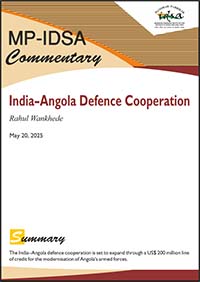India–Angola Defence Cooperation
- May 20, 2025 |
- IDSA Comments
Introduction
The State visit of President João Manuel Gonçalves Lourenço of Angola to India, from 3 May to 5 May 2025 marks an important shift in the evolving partnership between New Delhi and Luanda. As the two countries commemorate 40 years of diplomatic relations,[1] the visit added a new strategic dimension to the bilateral ties, that of defence cooperation. At the heart of this shift lies India’s announcement of a US$ 200 million line of credit (LoC) for the modernisation of Angola’s armed forces.[2] Apart from discussions on the supplies and repair of weapon systems, India expressed its willingness to train Angola’s armed forces. Multiple MoUs were signed in sectors such as energy, capacity-building, space technology and digital public infrastructure. As the current chair of the African Union, Angola’s growing defence ties with India carry wider continental significance. These signalled a shared interest in broadening cooperation beyond traditional domains.
A Convergence of Needs and Capabilities
Angola’s defence forces, equipped predominantly with Soviet-era military hardware, need support in maintenance, modernisation and logistics. As Secretary (Economic Relations) Dammu Ravi observed, Angola has “a large number of Soviet defence equipment, which needs to be serviced, overhauled and maintained”.[3] He noted that Angola was already in discussions with Indian public and private sector companies for sourcing equipment and undertaking repairs.[4] Some of the common Russian/Soviet origin military equipment used by armed forces of India and Angola are listed below.
| Sr. No. | Name of Weapon | Type |
| 1. | AK-47 | Assault rifle |
| 2. | RPG 7 | Rocket launcher |
| 3. | T-72 | Battle tank |
| 4. | BMP | Infantry combat vehicle |
| 5. | BM-21 GRAD | Multi-barrel rocket launcher |
| 6. | SCHILKA | Air defence gun |
| 7. | MIG-21 | Fighter jet |
| 8. | SU-30 | Fighter jet |
| 9. | MIG-23 | Fighter jet |
| 10. | AN-32 | Transport aircraft |
| 11. | IL-76 | Transport aircraft |
| 12. | Mi-17 | Helicopter |
| 13. | Pechora | Air defence missile system |
| 14. | R-27 and R-73 | Air to air missile |
Source: Compiled by the author from open-source information.
India’s defence industry as well as its armed forces have a significant experience in the maintenance, repair and upgrade of all the above weapon systems. The shared legacy of weapon systems opens up avenues for defence industrial cooperation, particularly in spares, logistics, repair, overhaul and maintenance. This compatibility presents an opportunity for both countries—Angola can cost-effectively maintain and upgrade its assets, while India can deepen its defence exports and strategic influence in Africa by offering products, services and consultancy.
Leveraging the Line of Credit Mechanism
The US$ 200 million LoC is expected to facilitate Angola’s procurement of Indian defence goods and services under concessional terms. India has effectively used this mechanism in other parts of the Global South—such as Bangladesh, Sri Lanka, Mauritius and Seychelles[5]—linking concessional finance with enhanced defence exports and capacity-building. Under LoC norms, 75 per cent of the contract value must be sourced from India[6]—which ensures benefits for Indian defence manufacturers while also supporting Angola’s defence modernisation needs. Ensuring follow-through on the line of credit will be key to translating its intent into tangible India–Angola defence cooperation.
The credit line, therefore, can serve both strategic and industrial objectives, enabling India to project itself as a reliable defence partner in Africa. The Angola credit line aligns with this model and is poised to facilitate procurement of Indian defence equipment and services. Beyond the immediate financial benefits, the move signals India’s intention to become a reliable and long-term security partner for African nations.
Laying the Ground for Long-Term Defence Partnership
Angola is India’s second-largest African supplier of crude oil and liquefied natural gas, after Nigeria.[7] With energy security high on India’s strategic agenda, enhanced defence cooperation provides a framework to ensure the safety of maritime routes and infrastructure essential for energy trade. The deepening of bilateral relations in both energy and defence points to an emerging strategic convergence between the two nations.
Angola’s current role as Chair of the African Union in 2025 adds further strategic weight to its engagement with India. As AU Chair, Angola holds the responsibility of guiding the continent’s collective priorities—including regional defence cooperation. India’s deepening bilateral cooperation with Angola, therefore, has the potential to spill over into broader defence and security dialogues between India and the African Union as a whole.
While the LoC is the first of its kind with Angola in the defence domain, the two sides have engaged previously in military-diplomatic forums. Angola has participated in Indian defence expos, including DefExpo 2016 and DefExpo 2020, and India–Africa Defence Ministers’ Conclave in Lucknow in 2020. India and Angola had previously institutionalised their broader bilateral engagement through the Joint Commission Meeting (JCM), established in 2017.[8] The first JCM in 2020 saw discussions on expanding cooperation in areas such as defence, agriculture and telecom.[9] Defence cooperation now appears to be entering a more structured and substantive phase. Going forward, the India–Angola defence cooperation could encompass much more of the following aspects.
Training and Capacity-Building
Angola can benefit from sending military cadets and officers to Indian defence training institutions for basic training, technical and staff courses and also high command courses. The joint press statement mentions that India would be glad to cooperate in the training of Angola’s military.[10]
Military Exercises
There is potential for bilateral and multilateral army and naval exercises, enhancing interoperability and regional security cooperation. Facilitated by similar military equipment on both sides and Angola’s location on the western coast of Africa, regular port calls and institutionalised military exercises can be a good starting point. Previously, an Indian naval ship INS Tarkash had made a goodwill visit to Luanda in 2017, as a part of the Indian Navy’s overseas deployment.[11] This was followed by a port visit of INS Sumedha in 2023, which was also utilised for conducting a maritime partnership exercise with the Angolan Navy.[12]
Angola’s strategic location along the southwest coast of Africa—with a 1,600 km-long Atlantic coastline—makes it a key player in the maritime security architecture of the Gulf of Guinea, a region increasingly impacted by piracy, illegal fishing and maritime trafficking. Angola, in partnership with other countries in the Gulf of Guinea, has been trying to reduce maritime crimes and piracy.[13] It could thus be a suitable candidate for participation in the Africa India Key Maritime Engagement (AIKEYME) military exercise floated by the Indian Navy in April 2025. AIKEYME aims to develop collaborative solutions to regional maritime challenges through improved interoperability thus strengthening India’s relations with African littoral countries.[14]
Participation of Angola in future editions of AIKEYME could further enhance its naval interoperability with regional partners and India and also signal Luanda’s commitment to collaborative maritime security efforts. As India continues to shape its maritime outreach in Africa, Angola can become a key node on the Atlantic flank of this engagement strategy. In doing so, India not only enhances its influence but helps construct a cooperative, multipolar maritime order that acts as a counterweight to Beijing’s more assertive military and commercial expansions.
Military Technical Support
The Indian Navy has a rich legacy of technical assistance in conducting Exclusive Economic Zone (EEZ) surveillance, hydrographic assistance, maritime domain awareness exercises, etc. The Indian armed forces have a range of capacity-building and capability enhancement initiatives that could be leveraged to develop a strong bilateral defence cooperation.
Conclusion
The Angola–India defence partnership is still in its nascent stages but holds significant promise. The combination of compatible defence platforms, mutual interests in regional maritime security, and India’s expanding defence production capabilities can make this cooperation a model for South-South defence cooperation. The India–Angola defence cooperation initiative thus marks a promising convergence of strategic intent and practical capability. As Africa’s geopolitical profile rises and external actors intensify their engagements in this continent, India’s no-strings-attached outreach grounded in mutual respect, capacity-building and South-South solidarity offers a distinct and credible model of partnership.
Views expressed are of the author and do not necessarily reflect the views of the Manohar Parrikar IDSA or of the Government of India.
[1] “India Angola Agree to Deepen Energy and Strategic Ties”, DD News, Government of India, 4 May 2025.
[2] “English Translation of Prime Minister’s Press Statement during Joint Press Statement with President of Angola”, Media Center, Ministry of External Affairs, Government of India, 4 May 2025.
[3] Ibid.
[4] Keshav Padmanabhan, “Angola to Source Defence Equipment from India”, The Print, 3 May 2025.
[5] “Line of Credit”, Press Information Bureau, Ministry of External Affairs, Government of India, 23 December 2015.
[6] Ibid.
[7] “India Angola Agree to Deepen Energy and Strategic Ties”, no. 1.
[8] “Bilateral Brief on India-Angola Relations”, Embassy of India in Luanda, April 2023.
[9] Ibid.
[10] “English Translation of Prime Minister’s Press Statement during Joint Press Statement with President of Angola”, no. 2.
[11] “Press Release”, Embassy of India, Luanda, Angola, June 2017.
[12] “INS Sumedha Made a 3-day Port Call to Angola”, Millenium Post, 8 November 2023.
[13] Aroonim Bhuyan, “Energy, Defence And Development: India Set To Deepen Ties With Angola During President Lourenco’s Visit”, ETV Bharat, 1 May 2025.
[14] “Africa India Key Maritime Engagement 2025 Inauguration”, Press Information Bureau, Ministry of Defence, Government of India, 13 April 2025.






